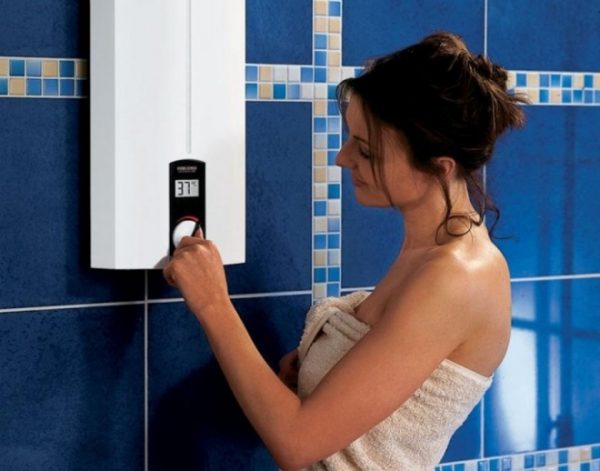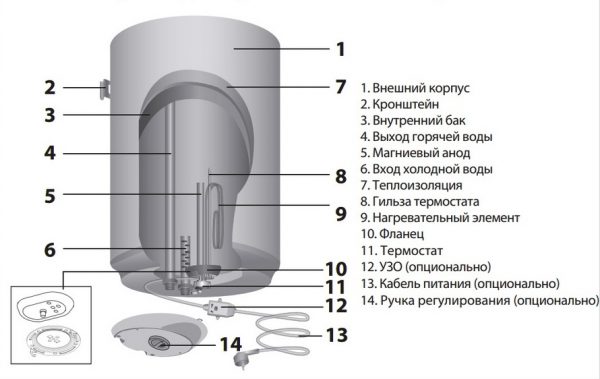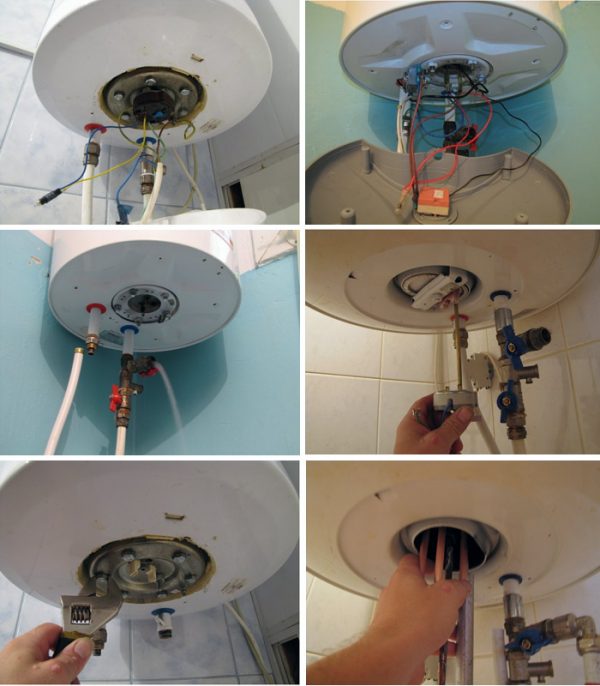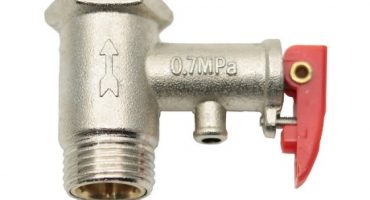Water heaters are used as the main or additional source of hot water supply in apartments and country houses. A complex device can fail for various reasons, breakdowns deliver a lot of domestic inconvenience and require urgent removal. Let us consider in more detail why cold water does not enter the water heater, why the pressure may decrease, and why there are difficulties with heating.

Water heater
Why the water heater is not working
First of all, you need to deal with the cause of the problem. Most often, owners of water heating equipment encounter the following malfunctions:
- The pressure of the water at the outlet of the water heating equipment is reduced.
- The boiler draws water and heats it, but there is no water at the outlet.
- Water does not enter the tank of the water heater.
The boiler is a complex system consisting of many pipes of various diameters, filters, valves and gates. The failure of any node can lead to improper operation of the entire system.

Boiler design
Here are the main causes of malfunctions:
- Deposition of insoluble carbonate salts (scale) on pipe walls, valve parts or valves.
- Particles of rust.
- Blocking the flow of water by an air bubble.
- Failure of a valve or valve (jamming of parts).
First of all, you need to find the problem node. To do this, sequentially disconnect the parts from the entrance and see after which node the water will stop flowing into the system. When the problem area is found, you can proceed with the repair.
Important! Any actions associated with opening the body of the water heating device will lead to the loss of the right to warranty service. Start work only if the warranty has expired. Otherwise, it is advisable not to violate the warranty rules, but to contact the service center.
Trouble-shooting
Having found the problem node, you need to start restoring the boiler. The procedure depends on the specific reason that impedes the normal operation of the device. Consider the most common situations.
Scum clogging

Scum of water heater
Scale is deposits of insoluble carbonate salts on the walls of water heating appliances. It is found in teapots, washing machines, water heaters.
The amount of scale depends on the hardness of the water. In regions with hard water, even during the year of operation of the boiler, the amount of salts deposited on the walls may be enough to completely block the lumen of the tubes of the heating element or substantially narrow it.
If scale has caused the heater to fail, repair must be carried out in the following order:
- Open and remove the protective cover from the water heater.
- Unscrew the nuts holding in place the heater and remove it.

Dismantling of heating elements
- Wash boiler walls and the heater coil from carbonate deposits. Dissolving a hard crust will help organic acid - lemon or oxalic. You can use industrial products - decalcifiers. Soak the part in an acid solution to free it from accumulated deposits.

Descaling TENA
- Using a tester, make sure that the TENA spiral does not burn out due to a violation of the heat removal from the scale.
- If the spiral is intact, reassemble the device in the reverse order of dismantling.
If the heater fails, you have to look for a new one or buy a new boiler - you need to choose the most economical solution. If repairs require large financial costs, it is more profitable to immediately purchase new equipment.
Pressure reducer failure
The pressure drops of the incoming water in the system can be from 2.5 to 7 atm. To compensate for surges at the entrance to the boiler, a special unit is installed - a gearbox. Its task is to ensure equal pressure at the outlet of the boiler and the tap. If it fell due to a gear failure, it is necessary to adjust its operation or replace a broken part.
Low pressure in the main water supply also leads to a drop in pressure at the outlet of the water heater or in a flow heater. Unscrew the hose and check the pressure level: if water comes from a main water supply in a thin stream or does not go at all - it is worth waiting, as the problem may arise due to repair work. If the pressure has not recovered within a few hours, you should contact Vodokanal.
Thermostat breakdown
If the water leaving the boiler does not heat up enough or does not heat up at all, the thermostat may be out of order - it is he who is responsible for maintaining a constantly high temperature. To carry out diagnostics, turn off the power to the boiler and remove the thermostat from the housing.
Then you need to perform the following steps:
- Press the thermal relay button.
- Heat the copper tip of the thermostat. If the node is healthy, the button should turn off.
- Ring the thermostat circuits using a tester.
Typically, a thermostat malfunction is caused by overheating protection. As a result of the operations, the device should work, and the malfunctions will disappear after its installation in place. If the tester shows an open circuit, you will have to replace the blown thermostat.
Mixer clogging
If the water exits the boiler with sufficient pressure and runs slowly from the faucet, the reason lies in the clogging of the mixer with scale or rust. You will need to turn off the water, disassemble the mixers and carefully clean the filter mesh. You also need to inspect all the sealing gum and make sure that the crankshafts are working properly.
If water does not enter the boiler
If the described reasons are eliminated, there is water pressure, but the boiler still cannot be filled, the cause may be incorrect connection (inlet and outlet pipes are mixed up) or clogged mesh filter pad. It is easy to fix these problems: unscrew the hoses, rinse the filter and assemble everything back in the correct order.

Water heater operation scheme
Another cause of the malfunction is a check valve failure. It is installed at the entrance to the storage tank and does not allow water to return to the water supply. It can also release excess pressure during overheating. Over time, the valve spring becomes clogged with particles of scale and rust; as a result, the valve sticks. Disassembly and thorough cleaning will help to fix the problem. If you failed to clean the part and restore its functionality, you will have to look for a replacement.
Boiler Care: Useful Tips
Having figured out why the boiler may stop working normally and how to eliminate the most common malfunctions, it is worth stopping at preventive measures.
Most breakdowns can be avoided by following simple care recommendations:
- Do not overheat water. Lower temperature - scaling is formed more slowly, leading to breakdowns.
- The design of many boilers provides for the use of softening cartridges. Do not save on softening water, as this will help to avoid the cost of repairs.
- When leaving for a few days, turn off the device without draining the water. But disconnecting at night to save energy is impractical due to the large wear of the electrical part.
Following these simple tips, you can keep the heater working for many years, and if it fails, quickly return it to work.



